Welcome to our blog for the Plastic in the Pacific Crusade. If you missed the earlier editions please go to category file in the footer to go back and read them. They are listed under Plastic in the Pacific. Over the coming year we will be writing regularly of our adventures and what we are seeing. In this article we write about our transit from Galapagos to Marquises
Departing Galapagos was a hard thing to do. It was such an amazing place, however in store for us over the other side of the pond was the south Pacific Islands and some of the most amazing diving and people in the world. The Marquises is a place that many people don’t know about. It is pretty remote, however for anyone crossing the Pacific, this is your first port of call. I’d heard only one thing about these islands, they rise up out of the depths of the Pacific, high into the sky. That is literally what I knew before I researched the islands for our journey.
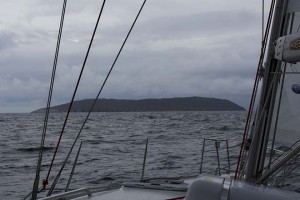 The distance from Santa Cruz Galapagos to NukuHiva Marquises was 3019nm on a direct route. Once again , we were travelling early in the season due to our commitments in the South Pacific and wanting to spend as much time there as possible. Usually people would transit between March and October, that is when the trades blow consistently. We had been watching the weather for a week prior to departing. One good thing about leaving early is we didn’t need to motor south to get to the trades like usual. If you read every blog about the ‘Milk Run’ you will read that you head south until you hit the SE trades and then head west on these until the trades move east closer to the Marquises and that will allow you to head south into the islands. It is pretty much a downwind run.
The distance from Santa Cruz Galapagos to NukuHiva Marquises was 3019nm on a direct route. Once again , we were travelling early in the season due to our commitments in the South Pacific and wanting to spend as much time there as possible. Usually people would transit between March and October, that is when the trades blow consistently. We had been watching the weather for a week prior to departing. One good thing about leaving early is we didn’t need to motor south to get to the trades like usual. If you read every blog about the ‘Milk Run’ you will read that you head south until you hit the SE trades and then head west on these until the trades move east closer to the Marquises and that will allow you to head south into the islands. It is pretty much a downwind run.
We departed with a similar weather forecast except that we could sail west immediately as the trades were in the Galapagos and hence no light wind to deal with. Departing on the 4th January at 12 noon, we had a SSE of 12-15 knots. This was perfect for the run across to the southern end of Isabela Island which was slightly south of West. It’s an angle that Susky loves. She would sit on 7-9 knots the entire way. Ideally we wanted to get away a little earlier to clear Isabela by nightfall however leaving at 12 noon meant we would reach Isabela at night. It just meant we kept a wider berth of the island for safety.
It rained a lot and it was overcast the first couple of days and once we cleared the islands, the swell calmed down and the current set in at 1-1.5 knots in a NW direction which would help us immensely for the first 2 weeks. It allowed us to sail a hotter angle (higher into the wind and hence faster). If you sail too low the boat is slow, so we would sail faster and get an assist along the way. It also calmed the waters down so it was really pleasant sailing. We didn’t want to go too far north due to being so close to the equator and having light winds north of our course. So we would end up beam reaching for the first 5 days, not needing ‘Sunny’ our spinnaker until the 9th when late in the day we would run it for 3 hours only. Speeds were fantastic in the first week and the skies slowly cleared so sailing was very pleasant. The best part is we were covering great ground toward our goal although the last week of the trip was changing every schedule with regards to weather forecast.
One of the reasons we are on this campaign was that in the 2008 Sydney to Hobart on Rudy Weber’s Too Impetuous, we launched a message in a bottle to see where it would end up. It was found over 2 years later on the Queensland coast, about 1200nm against the prevailing currents. The most likely route it took was a tour of the Pacific as the currents in the south pacific travel anti-clockwise. How far it went we will never know. So we decided to do another experiment and dropped our own message in a bottle some 500nm west of the Galapagos. Refusing to put plastic in the ocean, it was a nice wine bottle so hopefully it will be found some time down the track and we will be notified.
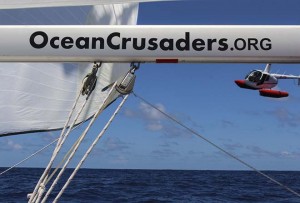 On Sunday the tenth, I’m down just going to sleep when Annika yells out ‘I think I hear a helicopter!’ I thought she had lost it. Initially I thought it was the wind generator and then she yells out again, ‘It is a helicopter’. By this time we are about 1000nm from land. I don’t know the range of RB44MKII helicopters but sure enough, out of the blue comes this small white helicopter with big red pontoons. It buzzes us so close that we could almost see the instruments. I have never had a photo helicopter that close to a yacht ever but he knew what he was doing. They fly off into the distance and another one appears and does the same thing. Since departing we hadn’t seen a boat, there was nothing on AIS and here are these two helicopters that could not make it across the ocean if they tried. I came up with a theory that maybe their floats were full of fuel or something like that and that they were adventurers on a mission.
On Sunday the tenth, I’m down just going to sleep when Annika yells out ‘I think I hear a helicopter!’ I thought she had lost it. Initially I thought it was the wind generator and then she yells out again, ‘It is a helicopter’. By this time we are about 1000nm from land. I don’t know the range of RB44MKII helicopters but sure enough, out of the blue comes this small white helicopter with big red pontoons. It buzzes us so close that we could almost see the instruments. I have never had a photo helicopter that close to a yacht ever but he knew what he was doing. They fly off into the distance and another one appears and does the same thing. Since departing we hadn’t seen a boat, there was nothing on AIS and here are these two helicopters that could not make it across the ocean if they tried. I came up with a theory that maybe their floats were full of fuel or something like that and that they were adventurers on a mission.
I have seen the engines in these things and they are a 260hp motor not much larger than a lawn mower. I was sure there had to be a boat around but with nothing showing, we were at a loss to explain these mysterious craft. Later that night our question was answered when a large motor vessel with big towers on it and nets on the back went by in the distance and the helicopters landed on the roof. It was really suspect and we got to thinking that it was a whale hunting vessel. However it could also be a tuna boat as they do use helicopters to spot big schools of Tuna. Just weird that these looked like recreational craft. I guess we’ll never know. The call sign on the tail of one of the choppers was HP-1484 and the other one was HP-1756 if anyone knows how to look that up?
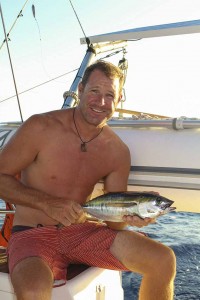 Our first week under our belt and we had covered 1147nm to the goal. 200 of these had been courtesy of the currents. It meant you didn’t need to push the boat to get the speeds and we were really enjoying the sail. However our plan to get some food fishing was going astray. We had lost our favorite lure coming into Panama and the replacement was not ‘luring’ anything. Every day it would go out, every day it would come home lonely. By the second week the wind had moved from SSE to SE, however that just meant that during the day we would run ‘Sunny’. With winds of approximately 10-15 knots consistently we kept speeds of 6-8 knots. It was epic sailing conditions and the waters had turned that magical blue again, after the greenish seas that had surrounded the Galapagos. Finally on the 15th, 11 days into our sail, we caught a yellow fin tuna. 2 meals would be had so the fishing line went away for a couple of days.
Our first week under our belt and we had covered 1147nm to the goal. 200 of these had been courtesy of the currents. It meant you didn’t need to push the boat to get the speeds and we were really enjoying the sail. However our plan to get some food fishing was going astray. We had lost our favorite lure coming into Panama and the replacement was not ‘luring’ anything. Every day it would go out, every day it would come home lonely. By the second week the wind had moved from SSE to SE, however that just meant that during the day we would run ‘Sunny’. With winds of approximately 10-15 knots consistently we kept speeds of 6-8 knots. It was epic sailing conditions and the waters had turned that magical blue again, after the greenish seas that had surrounded the Galapagos. Finally on the 15th, 11 days into our sail, we caught a yellow fin tuna. 2 meals would be had so the fishing line went away for a couple of days.
We have a policy on our yacht, not to fly the spinnaker at night. With a shift change at 2000 ship time, which was about 45 minutes after dark by that time, I am still flying the kite as we have a bite to eat. I am down washing the dishes and then the plan was to drop the kite for Annika’s shift. Well we didn’t get to the planned drop as Annika shouts out ‘The Spinnaker is gone’ I hear it fluttering in the wind and fear that the halyard has snapped and it is dragging in the water behind us. Getting on deck and running forward I see that the tack line is gone and it is fluttering in behind the mast. Quickly it is socked and lowered to the deck. Basically the tack line strop I had built had broken. Not bad, it had covered some serious miles and would be easily replaced.
After 2 weeks at sea we have covered 2213nm to the goal with 358 of those courtesy of current, however now our days were only getting 6-7nm of assist so things were changing. Our last week of weather into Marquises was sill changing daily with northerlies planned for the last 2-3 days, possibly light, maybe heavy. So our routing was changing continuously. We had decided to go where the wind took us and as the routing from Maxsea came more clearer, we would gybe as required. After 15 days of being on port tack, we would gybe onto Starboard. It would last for just over an hour as a rain squall went through.
So what do you do when you are out at sea for so long. Well let’s just say that I think I am now perfectly qualified to be either a psychopathic serial killer or kidnapper, or I should go the other route and be a private detective. If I went with the second option I would surely refer to all the crime thriller novels by the likes of James Patterson, David Baldacci and similar. I have read so many similar books, it is getting a bit crazy. Lucky we have lots of books to choose from and hopefully soon I’ll find something different to read, although I have to admit that I like these authors and can read a book in 24 hours when out at sea. Not bad for someone who never reads when on land.
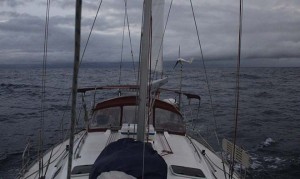 In the first 16 days we had no wind over 20 knots and nothing much below 10 knots, very similar to our Atlantic crossing. Annika would be on deck early one morning when a rain squall come through. It looked like every other squall that would require a small reef in main and headsail for about 30 minutes before passing and going back to full sail. This one would be different. We actually had winds up to 25 knots so we reefed down further than usual. It lasted about an hour and then we were back to full sail again as the skies cleared. That afternoon we nailed a blue fin tuna just before dark. Happy days, another 2 meals for us.
In the first 16 days we had no wind over 20 knots and nothing much below 10 knots, very similar to our Atlantic crossing. Annika would be on deck early one morning when a rain squall come through. It looked like every other squall that would require a small reef in main and headsail for about 30 minutes before passing and going back to full sail. This one would be different. We actually had winds up to 25 knots so we reefed down further than usual. It lasted about an hour and then we were back to full sail again as the skies cleared. That afternoon we nailed a blue fin tuna just before dark. Happy days, another 2 meals for us.
The last 4 days would see us gybe a lot, reef the sails with every rain squall that came through, head north, then south and all over the place. The routing still was changing all the time and our ETA was changing continuously with it. As we get closer, we really get a little impatient and just want to be there to start exploring. Also after so long at sea, it would be nice to stop. Being a ‘numbers’ person, I start calculating distance and possible ETA’s. Our hopes of a Saturday finish went out the window when with 170nm to go, we get a storm come at us from the west. Motor sailing into it, we were initially doing just 2.5 knots. It was a bit strange as we knew we could motor faster than that. Looking over the side and we could see that that the slime from the Galapagos was back and climbing up the hull. For about a foot from the waterline the boat was green. It was a bit embarrassing but what could we do. Susky looked neglected. It made us wonder what the bottom would look like.
Eventually the winds would go back to the north and we would end up beam reaching towards Nuku Hiva. The rains became more persistent the closer we got to the islands. It seemed that these island had their own micro-climate like the Galapagos Islands. Our ETA was looking like Sunday morning early hours and then we get a bit of current assist again. By this stage we are motor sailing in 6-8 knots. We had an idea to pull into an island 30nm east of Nuku Hiva if we got their in daylight hours. We would anchor for the night and then travel to the bigger island the next day. Of course we had no such luck so we continued onto Taiohae Harbor on Nuku Hiva through the rain.
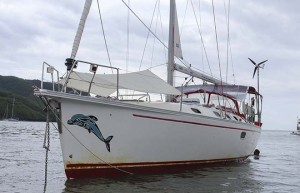 As regular readers will know by now, we always seem to arrive at night and guess what, no exception here. We approach the island in the dark with a full moon on our side, well it was till the rain clouds took it away. Passing the South East point and I knew there was a bay there with a small town further in. We saw just three lights. It wasn’t our bay anyway so we continued on and rounding the corner into the bay, there were plenty of lights on in this bay. As we entered the bay we realised a lot of the lights were swaying. Obviously a few yachts in this bay. We had no idea what to expect but with the remoteness of the island, we didn’t expect too many yachts. To our surprise there were quite a few. We would head into the bay and find a spot to anchor. Anchor down time was 0425 local time. We were pretty excited to be here and the silhouettes of the mountains rising high above the bay only added to this excitement. We couldn’t wait for sun up but we settled for a quick celebratory drink and then hit the sack for a few hours rest.
As regular readers will know by now, we always seem to arrive at night and guess what, no exception here. We approach the island in the dark with a full moon on our side, well it was till the rain clouds took it away. Passing the South East point and I knew there was a bay there with a small town further in. We saw just three lights. It wasn’t our bay anyway so we continued on and rounding the corner into the bay, there were plenty of lights on in this bay. As we entered the bay we realised a lot of the lights were swaying. Obviously a few yachts in this bay. We had no idea what to expect but with the remoteness of the island, we didn’t expect too many yachts. To our surprise there were quite a few. We would head into the bay and find a spot to anchor. Anchor down time was 0425 local time. We were pretty excited to be here and the silhouettes of the mountains rising high above the bay only added to this excitement. We couldn’t wait for sun up but we settled for a quick celebratory drink and then hit the sack for a few hours rest.
The next day would be a day of exploring, and cleaning. The hull certainly needed it and inside the boat had plenty of mould from the damp conditions of the Galapagos and the inability to dry/air anything out in over 19 days of sailing. What would we wake up to? Was this paradise? You’ll have to wait for the next blog to find out.
The STATS
Sightings: 3 x Coconuts, 2 x helicopters, 1 x ship/boat
3019nm distance, 2612nm sailed, 407nm current assist
2 fish caught, 1 message in a bottle sent
Time taken: 19 days, 20 hours.
In our next blog we explore NukuHiva Marquises.
Ocean Crusaders are out to change the way people treat our oceans. Our online education program is free to download at www.OceanCrusaders.org/education where children can learn of the issues our oceans are facing and how they can make a difference. The Plastic in the Pacific Crusade is about educating the South Pacific Islands, finding out what is happening in these islands and updating our programs. You can join us in the Pacific and see for yourself what we do.
Ocean Crusaders Plastic in the Pacific Crusade is proudly supported by: Cressi Dive Gear, Gill Marine, Keen Footwear Australia, Barz Optics Sunglasses, Maxsea Navigation Software, Digital Diver Cairns, LED Dive Lights Australia, Boat Names Australia, Predictwind Weather & Sail-world.com
[cincopa A8GACO9elzN9]
SIGN UP FOR OUR BLOGS